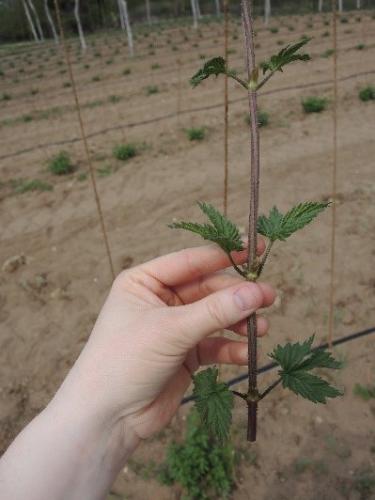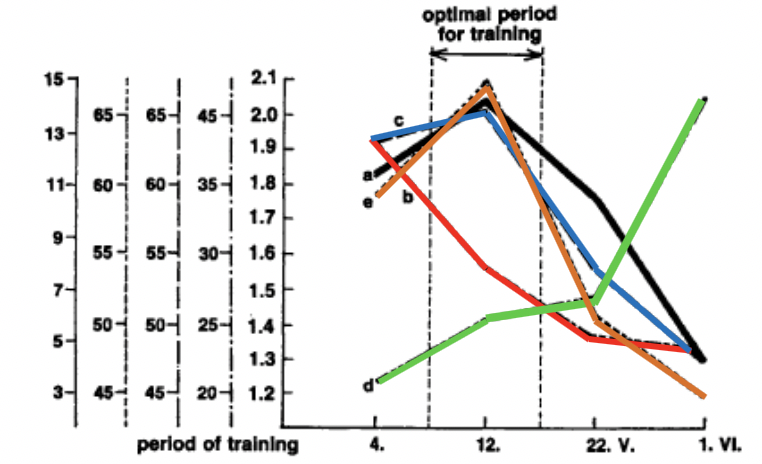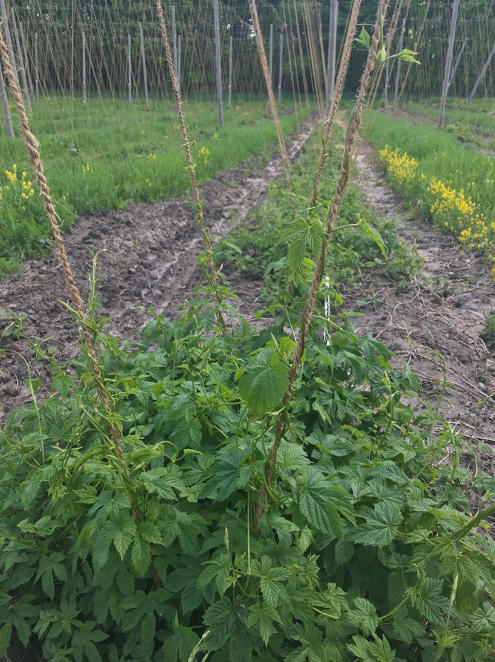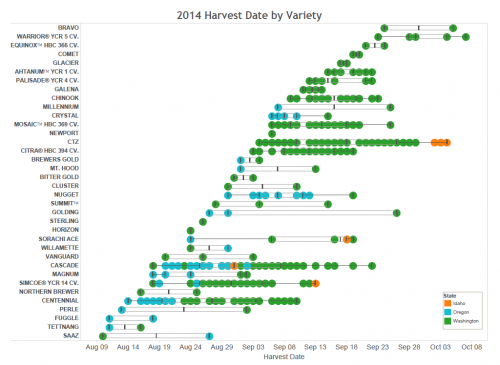Hop training
Best practices include proper bine selection and training date.

Training hop bines is a laborious task that involves manually wrapping the bines around a coir or paper string in a clockwise direction in order to encourage vertical growth (Figure 1). Training hop bines is not a perfect science, but there are a few critical aspects that can help growers optimize yield. Second year hop plants are generally productive enough to be trained with 2 to 4 strings per hill, depending upon planting density and hopyard layout. While some varieties will “self-train,” hop bines that have been selected and trained deliberately on the proper date can produce higher yields. It is important to remember that due to thigmotropism and phototropism, hop bines only climb in a clockwise direction around guide strings and will fail to climb if wrapped counter-clockwise.
Bine selection is critical. Crowns will produce a multitude of bines each spring. Early vigorous growth tends to be rigid and brittle (Figure 2), and can result in bines with long internodes that are not conducive to maximizing yield. By selecting more uniform and secondary shoots, growers can increase cropload and limit the risk of bines breaking in wind events. Producers should select succulent bines of similar height (approximately 2 feet). Selecting the appropriate number of bines is important and can vary by cultivar. For most cultivars, training 2 to 4 bines per string will result in the greatest yields.
  |
Figure 2: Early hop growth. Photo credit: Rob Sirrine, MSU
Training Date
While there are many important best management practices involved in the production of hops, one of the most crucial is training date. Rybacek (1991) cites data from a long-term experiment in Steknik (Bohemia) 50.3° N, 13.6° E that shows the optimum training date for Saaz is approximately May 12 (Figure 3). While delayed training tended to reduce cone length, it also resulted in increased cone density and thus overall yield. Since young hop shoots are affected by temperature, in cool, long springs, Rybacek suggests that the best yields will be achieved by training the secondary shoots once they reach around 60 centimeters (24 inches) on average, as opposed to the initial shoots that were exposed to
The date of pruning will play a direct role in determining regrowth and therefore the date of optimum training. In general, hops are pruned either chemically or mechanically, three to four weeks prior to training. Here in northern Michigan, there may be seasons where the hops do not emerge soon enough or produce enough shoots to prune. In years where this is the case, it may be better to forego pruning since doing so could delay the optimum training date and potentially reduce yield.

cold temperatures. Neve (1991) suggests 2 to 3 bines should be trained when they are approximately 1.5 feet in length and growers should not select the most vigorous bines.
Pruning and Training Date
Pruning involves removing the first flush of bines and sets the plant up for synchronized growth of more desirable bines. Growers must know their target training date and work backward to determine their pruning window. Typically, hops are pruned chemically or mechanically, approximately three weeks prior to the desired training window. Growers should consider the long-term weather forecast when making pruning decisions as cool wet weather may delay regrowth and hot weather may increase the rate of regrowth. In Northern Michigan, there may be years where the hops have not emerged or produced enough shoots to prune. In this case, pruning may delay the optimum training date and potentially reduce optimal growth and yields. Pruning is not recommended on baby hops or stressed plants.

Because we have a compressed growing season in relation to the PNW, optimum training dates in Michigan will likely differ. How is a grower in Michigan supposed to determine the optimum training date?
While no growing degree day or latitude or day length models have been developed to assist with training time, likely the best method is to work backward from typical harvest dates. Most early-harvested varieties will yield highest if trained early and most late-harvested varieties if trained later (Figure 6). However, this is not always the case for every variety and can vary by growing season. Depending upon location within the state, most growers in Michigan train hops from mid-late May.
Cultivar Considerations
Determining the optimum training date is difficult since the date can vary quite widely by variety. For example, in the Pacific Northwest (PNW) training date varies from the beginning of May through the third week of May depending upon the variety (Figure 5).
| Variety | Pruning Dates | Training Dates |
| Willamette | 4/12 | 5-1 / 5-3 |
| Cascade | 4/12 | 5-4 / 5-7 |
| Cluster | 4/17 | 5-7 / 5-8 |
| Millenium | 4/18 | 5-10 |
| Citra | 4-18 / 4-26 | 5-10 / 5-15 |
| Equinox | 4/26 | 5-16 / 5-17 |
| Mosaic | 4-26 / 4-28 | 5-15 / 5-20 |
| Zeus | 4-28 / 4-30 | 5-19 / 5-20 |
| Topaz | 4-30 | 5-20 |
Because we have a compressed growing season in relation to the PNW, optimum training dates in Michigan will likely differ. How is a grower outside of the PNW supposed to determine the optimum training date?
While no growing degree day or latitude or day length models have been developed to assist with training time, likely the best method is to work backward from typical harvest dates. Most early-harvested varieties will yield highest if trained early and most late-harvested varieties if trained later (Figure 6). However, this is not always the case for every variety e.g. Cascade, and can vary by growing season. Depending upon location within the state, most growers in Michigan will train hops from mid-May to June 1.

Take Home Points
- Training date can have a major impact on hop yield and quality.
- Training is affected by methods and timing of pruning that depend upon irrigation placement and practice, cultivar, vigor of the yard, yard age, latitude and location, timing, disease severity from the previous season, and seasonal growing conditions after the operations.
- There is no substitute for local, on-farm trials and experience to determine the optimum method and timing of pruning operation and training date.
- When producing a new variety, it is advisable to experiment with varying pruning and training dates over a period of several weeks to observe how plants respond.
- Keep detailed records of day length, growing degree days (MSU Enviroweather website), pruning dates, training dates, and yields.
- Control/Optimize plant growth prior to flowering. In northern Michigan bines should reach the top wire by July 10 at the latest.
- On an annual basis, determine how are the plants are positioned compared to a “normal” year?
-
- What has happened to the plant and its reserves prior to “normal” pruning date?
- Does a warm spring mean more growth than normal? Has the plant used all of its reserves?
- Were fall/winter conditions conducive to promote carbohydrate storage? Were other factors involved that could impact production (e.g. lack of chilling units, major disease issues, etc.).
- What are the expected temperatures for the next several weeks, that would promote growth (or lack thereof)?
- Will the plants achieve the growth that you are looking for, compared to a normal year, to get the vine structure for the best crop load?
- After pruning, train when shoot regrowth reaches 1.5 to 2 feet tall
- Train 2 to 4 vines clockwise around string
- Optimum number of bines to train can vary by cultivar
- Training is labor intensive - a crew of 10 can train ~ 10 ac per day
| Location | Latitude | Training Date Range |
| Southern Michigan | 42º | May 10 - May 30 |
| Central Michigan | 43º | May 15 - May 30 |
| Northern Michigan | 45º | May 25 - June 1 |
For monthly hop production updates during the growing season, please sign up for the Michigan State University Extension Bine and Dine webinar series: https://events.anr.msu.edu/Hopwebinarseries2020/ You will also be able to access previous recordings at your leisure. For more information on hops please visit the MSU Extension hops website at: https://www.canr.msu.edu/hops/.



 Print
Print Email
Email